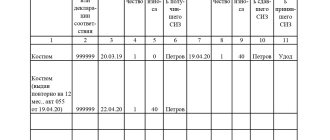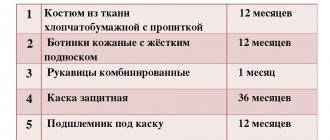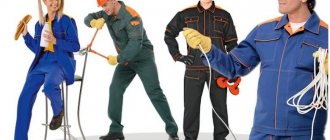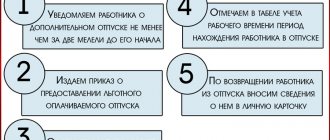The periods for wearing workwear are determined by special standards that are aimed at protecting the health and labor of workers in various professions.
According to current legislation, enterprises are required to issue uniforms appropriate to their activities to their employees.
Workwear is purchased at the expense of the employer. It is issued for a period of 1 year in a certain quantity, established documented. Therefore, employers try to choose good quality workwear that meets all requirements.
When does the period of use of the issued workwear begin?
The shelf life of workwear according to the law depends on the specifics of the activity, climate and work performed. The standards for the terms of use of workwear for 2021 are prescribed in the corresponding order of the Ministry of Finance No. 997n. It also indicates how and from what point the service life of CO begins to be calculated, when it needs to be changed, what rules apply to different enterprises, how to determine the wear and tear of clothing and the service life of PPE (personal protective equipment).
So, according to the order of the Ministry of Finance, the time of use of the “special clothing” begins to be recorded from the moment the worker signs in the journal about receiving the CO. This rule applies to the standard form. The accounting for the winter kit, which is often used for 4-5 months a year, depending on the region, includes the time that the CO remains in the warehouse.
Documents establishing the framework for the operation of overalls
GOST for workwear
State requirements are applied for sewing workwear, manufacturing safety footwear, PPE and RPE.
The documents state:
- material requirements: strength, shrinkage after several washes;
- antistatic properties;
- what threads to use when sewing;
- line width;
- quality of tailoring;
- sizes of cuffs, collars, flaps to pockets;
- testing.
Special assessment cards for working conditions indicate GOSTs, according to which clothing should be issued.
How standards for wearing workwear depend on the type of production
Standards for issuing workwear by profession
The legislative framework provides for the issuance of protective clothing and personal protective equipment to 195 types of professions. In general, the service life of workwear, the standards of which are prescribed in Resolution of the Ministry of Labor No. 997n, depends on three factors - climatic conditions, type of production and work responsibilities of the subordinate. So, for an employee of one workshop where metal is melted, the wearing standards will be different from the norms for an employee of the next workshop where the same metal is processed.
Additional factors:
- type of pollution;
- there is a danger of electric shock;
- temperature indicators;
- presence of toxic substances;
- work associated with increased risk.
How it looks like in an example. Let's say we have a fleet driver and a battery technician. For them, the terms of use of workwear at the enterprise, the table of which is in the above-mentioned resolution, is:
- The driver, who additionally carries out car repairs in the company’s garage, is entitled to the usual cotton overalls, which are issued for up to two years, and gloves, one pair of which is required for 2 months of use;
- For a battery operator, the standards provide for the issuance of a suit with protection from acid burning for 1.5 years and 6 pairs of rubber gloves for 1 year, rubberized boots and an apron with a bib for up to 2 years, gloves made of dielectric material, glasses and galoshes “until worn out.”
An example of standards for the use of personal protective equipment by a repairman
Additional Information! The duration of wearing overalls is additionally established by a special commission during production certification.
Organization of distribution of workwear
At enterprises or in organizational structures, the issuance of PPE can be organized as follows:
- The required quantity is determined in advance. Applications for next year are being prepared. Information about workwear is taken from special assessment cards for the conditions of the labor process. If the latter was not carried out, then according to industry standards.
- The prepared list is agreed upon with the representative of the occupational safety service, the enterprise accountant and approved by the head of the facility. Ideally, it will be completed in three copies, one to the supply department, the second to the accounting department, and the third to the warehouse manager for control.
- The purchase of workwear is carried out in accordance with the rules of procurement procedures. This requirement is established at the legislative level.
- After the workwear arrives at the warehouse, it undergoes entrance control. A special commission is being created for this purpose. If the control has not been passed, the goods are returned back to the supplier.
- Now the workwear is in the warehouse, followed by distribution to departments.
The correct organization of the process of receipt, acceptance and delivery is fixed in the Regulations or in the standard for the enterprise.
Establishment of the period: “until wear”
As already mentioned, some personal protective equipment is issued to the employee “until worn out.” This list includes a signal vest, the service life of which is unlimited, safety glasses, noise-cancelling headphones, knee and elbow pads, some types of support belts, etc. The issuance of new PPE is provided only in the event of loss, theft, breakage, obsolescence and beyond the operational time frame , installed by the manufacturer.
Sample order for standards for issuing workwear
Thus, for example, if for supporting belts GOST provides for maximum use for a period of up to 25 years, then if during this time it has not become unusable, it is in any case subject to write-off.
In addition, the employer must conduct regular inspections of personal protective equipment. The enterprise must have a log in which each inspection will be recorded.
Additional Information! Typically, for long-life PPE, inspections are carried out every six months or a year.
How to determine for accounting purposes the wear period of workwear if the issuance rate is set “until worn out”
Any wear time can be set for items of equipment, the main thing is that it does not exceed the standards for maximum use of the product by GOST or the manufacturer of the product.
For example, the useful service life of safety glasses can range from a couple of months to 20 years. Therefore, for accounting purposes, it is possible to establish a systematic write-off every year, referring to the conditions of the work performed.
Depending on climate
Since the operating time of winter and summer clothing may be different, depending on the weather conditions of the region and the seasonal work performed, the time of wearing them should also be different.
Lifespan of winter workwear
The service life of the winter set depends on the climate zone to which the region belongs. That is, there are no uniform standards and those responsible for the service life of work clothes must know their climate zone in order to write off CO on time.
Climate zones were established based on data on average annual temperatures and average wind speed. According to this principle, the territory of the Russian Federation is divided into 4 belts; the manager can find out his belt in the same order of the Ministry of Labor under No. 63. Each belt has its own class of protection, which must be provided by clothing. Class 1 refers to the warmest regions, class 4 to the harshest.
The service life for each class will be as follows
There is also a special climate zone characteristic of the Arctic. There, the winter set should be changed every 1.5 years, and shoes every 2 years.
For how long are summer work clothes issued to workers by law?
There are no fixed service periods for each type of activity. The law says that the service life of summer clothing is 1 year, but the commission must further consider the issue of a possible extension of the period if there are grounds for this.
Not every production facility provides shoes for the summer period. For each industry, the period will be different, depending on the conditions and specialization of the employee. But, according to the norms, shoes cannot be worn for more than three years.
What is usually included in the concept of winter special clothing?
- trousers or overalls with an insulating layer
- jackets
- vests
- insulated boots or boots
- felt boots
- The welder's winter suit is listed separately due to its special characteristics.
- hat with ear flaps
- fur gloves
When used, such clothing can perform not only a direct function of protection from low temperatures, but also a signal function. Reflective elements are applied to it.
Winter workwear, as well as any other PPE, are purchased by the employer and issued to each employee for use. The entire team must understand how important it is to keep such clothes in order, wash, clean and repair them on time, and store them correctly, because violating their integrity can negatively affect the health of the worker. Another point is that in the event of dismissal, all protective clothing issued to the employee must be returned to the warehouse, and if a loss occurs, the damage must be compensated at one’s own expense, this is indicated in the Labor Code of the Russian Federation. PPE is issued in a configuration regulated by a legal document:
“Standard standards for the free issuance of special clothing and special footwear to workers in professions and positions of all types of economic activities engaged in work with hazardous working conditions, as well as in work performed in special temperature conditions.”
These standards were approved by order of the Russian Ministry of Labor.
Overalls for line personnel
Depending on the type of production, line personnel include different groups of workers, not only those who work in production. This also includes catering workers, medical organizations, cashiers, salespeople, etc.
Their standards for compliance with workwear are approximately the same. Usually this is a cotton robe or a suit of jacket and trousers.
Additional Information! In winter, line workers who perform job duties outside are required to be given felt boots, a winter jacket or a quilted jacket.
The average service life of overalls for line personnel is limited to 24 months. In some cases this period may be 18 months. If the manufacturer does not indicate an expiration date, the clothing is disposed of after 24 months.
Extending the wearing period of workwear
Clause 6.17 of the standards for the service life of workwear provides for an extension of the wearing period of PPE. For this purpose, an inventory commission is assembled at the enterprise, which evaluates the further suitability of the overalls.
This practice is quite common. At some enterprises, due to the specifics of the position, workers may not wear special clothing, which needs to be changed every year, for two or three years.
At the same time, in the course of professional suitability for further wearing of clothing, a certificate is issued, which indicates all the defects existing at the time of inspection. If the flaws do not meet the standards for extending the service life of the PPE, it is written off. For example, if the percentage of engine oil stains on a mechanic’s uniform is less than 15, you can wait a while with the write-off.
Deduction of cost upon dismissal
It is important to understand that work clothes purchased for workers become the personal property of the enterprise, not the worker. Simply put, it is put on balance. Upon dismissal, the employee is obliged to return to the employer the protective clothing on the balance sheet.
Additional Information! If the dismissed employee does not do this, the employer has the right to withhold the market value of the purchased clothing from the calculated salary. But according to the labor code, the employer does not have the right to withhold more than 20% of the employee’s salary.
Violation of deadlines
When an employer neglects the established rules, certain penalties are imposed on him. You can see the possible violations and sanctions in the table:
| Type of violation | Amount of fine for the organization, rub. | Amount of fine for management, rub. | Amount of fine for an official, rub. |
| The procedure for issuing CO is not followed | 30 000 – 50 000 | 1 000 – 5 000 | 1 000 – 5 000 |
| Refusal to issue CO | 130 000 – 150 000 | 20 000 – 30 000 | 20 000 – 30 000 |
According to clause 28 of the Intersectoral Rules, every worker is obliged to take care of his set of CRM. In case of damage to the latter, you should report this to management.
An employee is prohibited from using his workwear outside of work and for personal purposes. Deliberate damage to uniforms (or failure to comply with labor discipline) is fraught with a fine in the amount of the full cost.
Remember that starting work without a working set of monitoring equipment is strictly prohibited. This can lead to trouble not only for the employee himself, but also for everyone around him.
How to report on the use of work clothes
Typically, the responsibility for keeping track of work clothes is assigned to a responsible employee, for example, a warehouse manager. But, according to the law, the main responsible person, who during the inspection will answer to the commission, is the immediate supervisor of production.
Reporting can be carried out both in written and electronic form, and can be presented either in a journal or in a card index.
PPE accounting scheme










